Recently, with the PCE inflation data and ADP employment data falling short of expectations, the market has fully digested the panic effects brought by the FED's hawkish rate cut in September. Liquidity has quickly recovered, and investors have become more confident in the expectation of two rate cuts within the year. This optimistic sentiment has also brought me considerable returns, stemming from an interesting project called NFTStrategy, which has seen a 20-fold increase in just one month since its launch. Although the investment amount is not large, I have some insights to share with everyone. Overall, NFTStrategy leverages the low liquidity characteristics of NFT assets and employs clever DeFi design to create a Degen strategy similar to a micro-strategy on-chain NFT vault. This project provides a great opportunity for readers to revisit the financial innovations reminiscent of the DeFi Summer of 2020.
Background of the NFTStrategy Project: TokenWorks
Before introducing the project mechanism, let me briefly introduce its background. NFTStrategy is backed by Token Works, an anonymous team focused on token design and experimentation, established in 2024. I have been following this team for quite some time, starting with a MEME token called PVP, which is their second project. In fact, since October 2024, before launching PunkStrategy, this team has launched a total of 10 DeFi projects, all focusing on Ponzi-style token economic model design. Their first and most well-known project prior to this was called Circle (O), an ERC 20 MEME token on Shape, which capitalized on the lack of available DEX and tradable token assets when Shape, an L2 focused on the NFT market, first launched. They deployed this MEME token and forked Uniswap V2 to provide a trading venue, while also designing a minimalist trading website where the market cap of the token determined the size of the circle displayed on the official website.
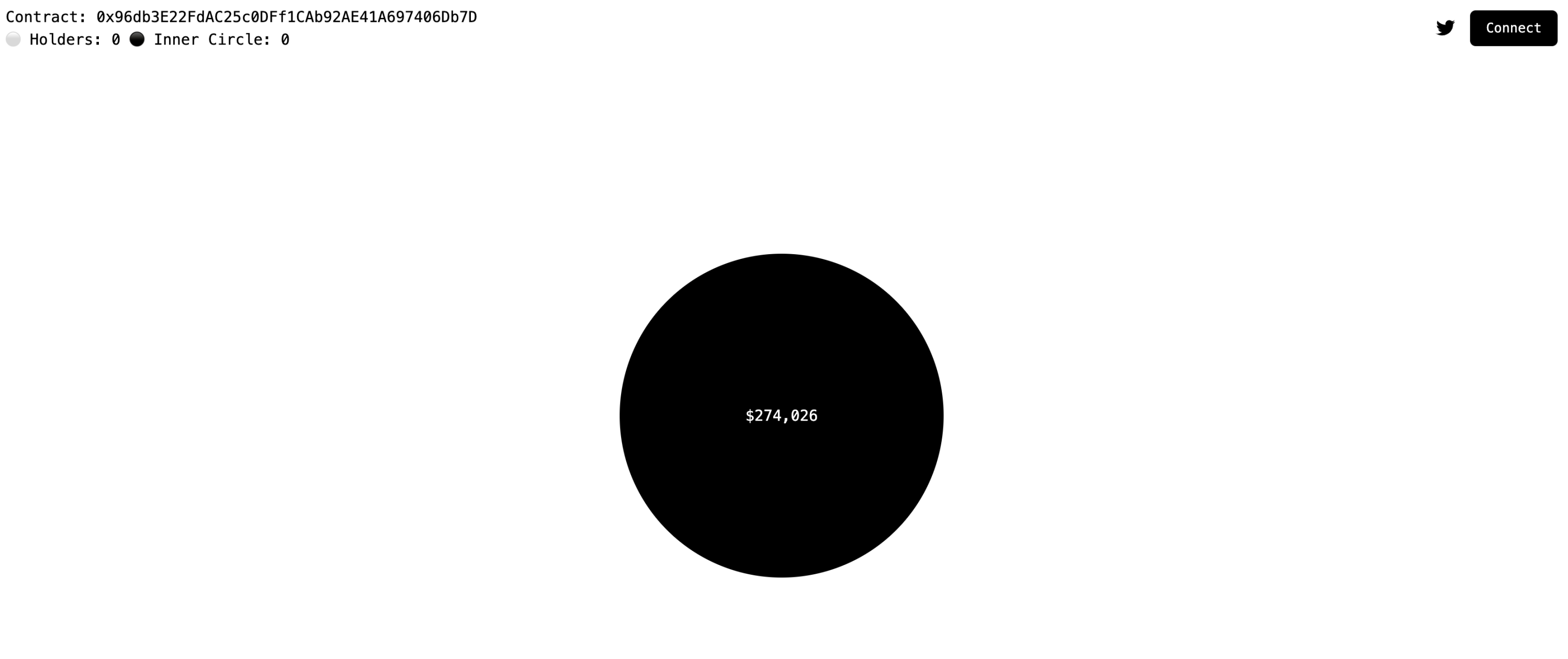
Subsequent projects featured various interesting designs around token creation, issuance, and trading mechanisms. For example, in the PVP project, anyone could "raid" the wallets of PVP token holders. The essence of the raid is a timed auction, starting at a price of 0.001 ETH. If no one bids against you within the specified time, you can acquire all the PVP tokens held by the raided wallet, while the raided wallet receives your bid.
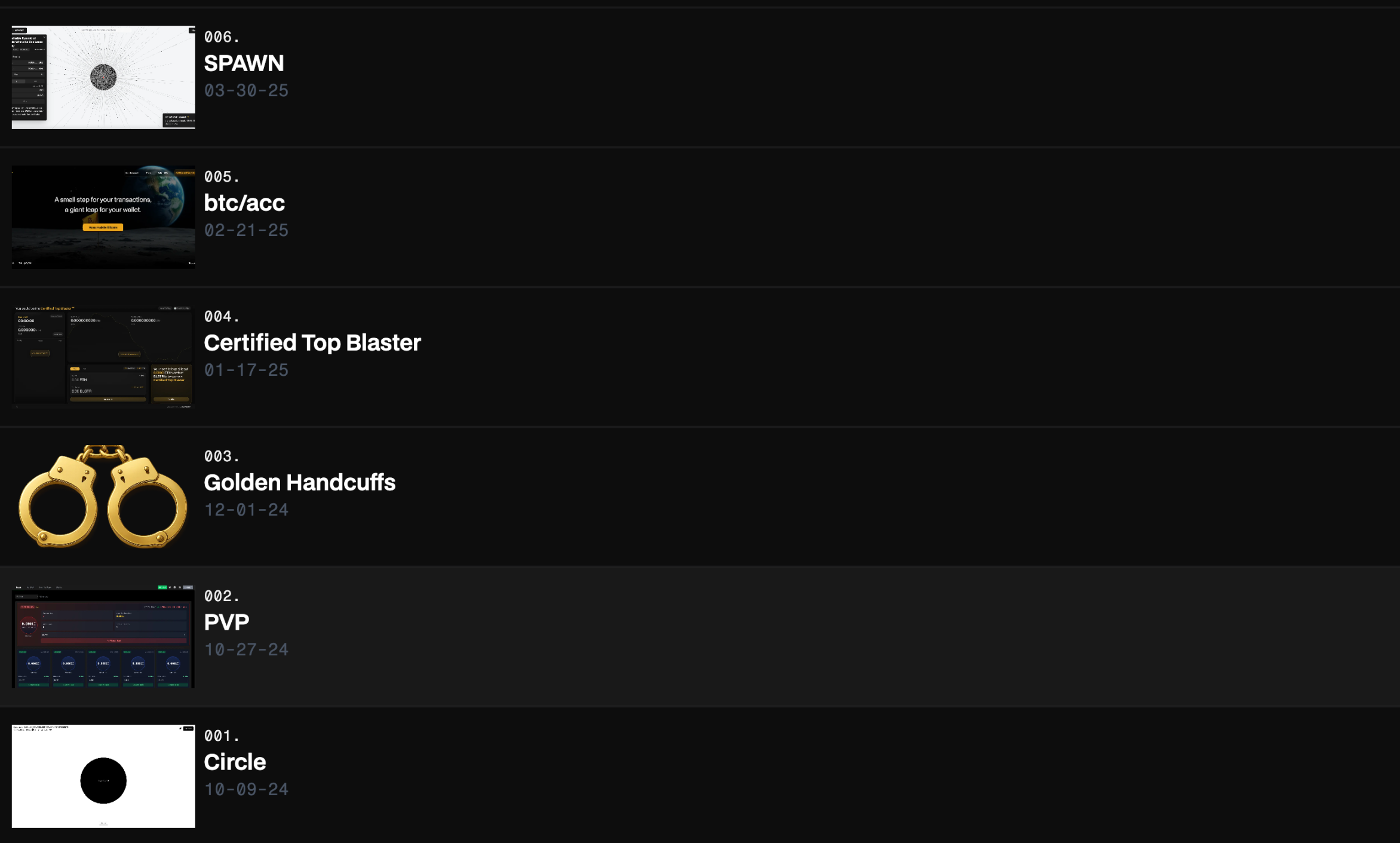
From the designs of these projects, we can see that the team is very skilled in innovating community fair launch-type MEME token economic models. In fact, this type of innovation was very common during the DeFi Summer phase, where people identified trading opportunities from various interesting Ponzi models and profited from them.
Although most of these projects have failed, during this process, the TokenWorks team has continuously accumulated its community influence and formed a scalable cold-start seed user group. This is crucial for the success of Fair Launch projects because, in most Ponzi models, if the scale of early participants is too small, it is easy for a few clever "whales" to monopolize after launch, breaking the preset game relationship and making the risk for later entrants extremely high.
Additionally, from archived documents, we can see that the team is also continuously accumulating experience in dealing with on-chain snipers and how to leverage mechanism design to activate KOL's dissemination effects to expand token influence. Overall, I see a team that embodies long-termism, is adept at summarizing and reviewing, and has strong resilience to setbacks.
The launch of PunkStrategy by the TokenWorks team on September 6 marked a new starting point for the story. The subsequent launch of NFTStrategy is a product that templates and platforms the token mechanism design of PunkStrategy. In less than a month after its launch, the price has seen an increase of over 20 times.
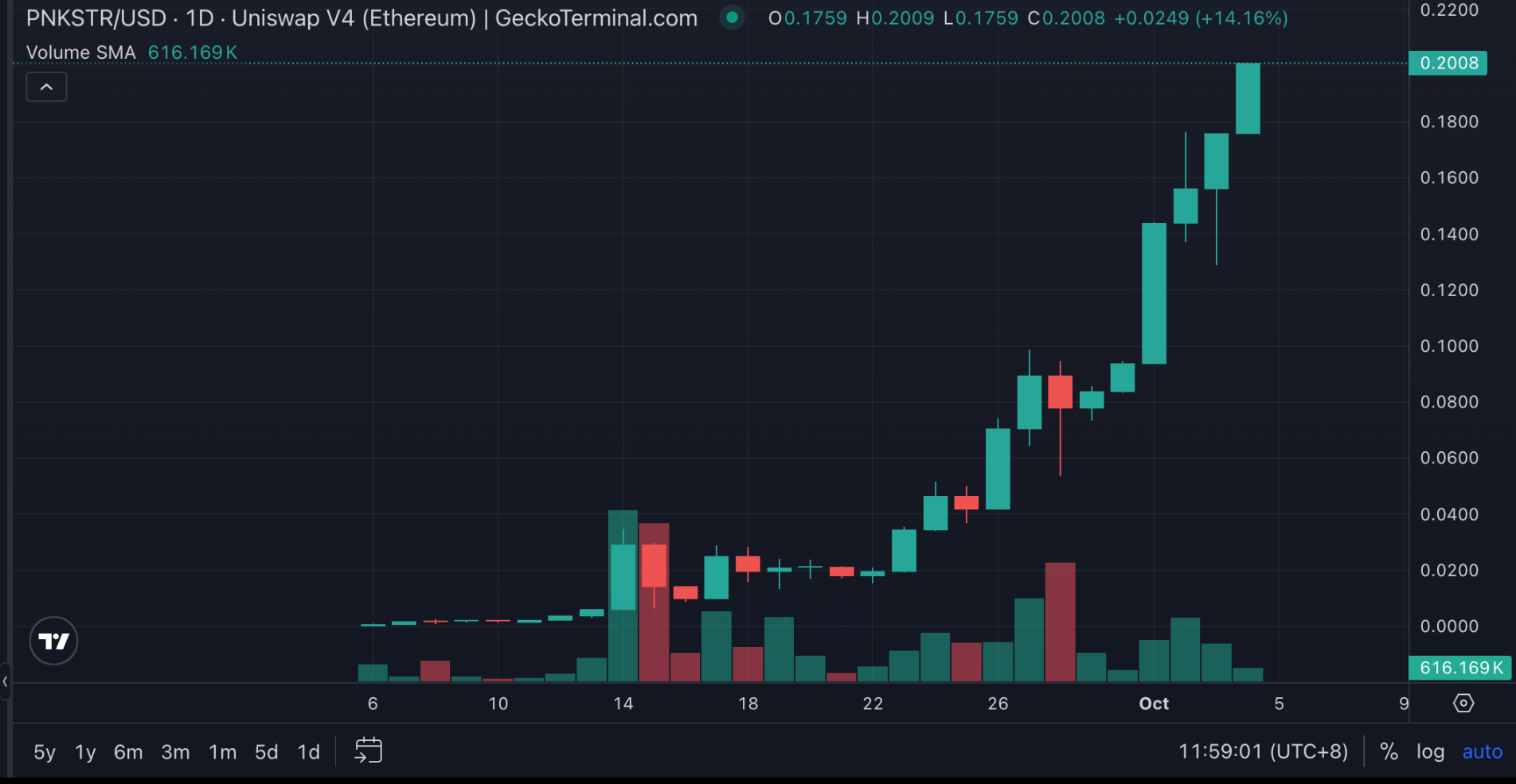
According to GMGN data, the holding distribution of the PUNKSTR token is relatively balanced, with the address holding the most accounting for 3.05% of the total. The top 20 holding addresses have all realized profits exceeding $1 million, indicating a strong wealth effect. However, with so much unrealized profit relative to only $4 million in liquidity and a market cap already reaching $200 million, it is still quite risky. Nevertheless, from the price trend, investor enthusiasm seems to be increasing. So what mechanism design endows this model with such magic? Let's detail it next.
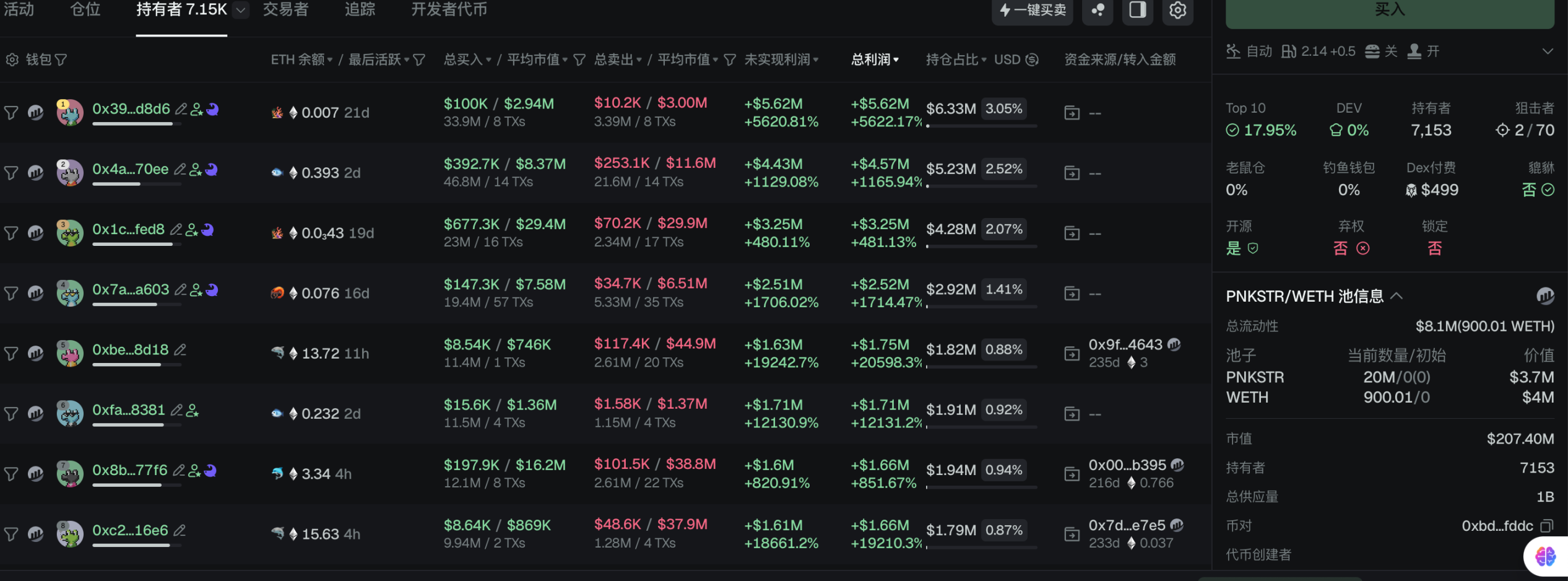
The DeFi Innovation Path of NFTStrategy: NFT Version of Micro-Strategy
In fact, the mechanism of NFTStrategy is quite simple. Essentially, NFTStrategy is an NFT vault that issues corresponding tokens and uses the fees generated from trading these tokens on Uniswap V4 to purchase blue-chip NFTs as vault reserves, thereby supporting the value of the tokens. The operational logic of the project is roughly as follows:
Users purchase a cryptocurrency called "Strategy Token," such as PUNKSTR (corresponding to the CryptoPunks collection). Each time someone buys or sells this token, the system charges a high fee of 10%. This fee is divided into several parts:
- 80% is automatically deposited into the vault to purchase floor-priced assets of the series (such as the lowest-priced Punks);
- 10% is rewarded to the original NFT creators or project parties;
- 10% is used for token buybacks and burns, reducing market supply to support token prices. It is worth noting that PunkStrategy's strategy differs slightly, with 20% of the tokens belonging to the team.
When the fund pool accumulates to a certain level, the system will automatically buy NFTs from the market and relist them at a slightly higher price (1.2 times the original price). If these NFTs sell, the ETH from the sales will be used to buy back tokens and burn them, thus forming a "circular flywheel": active token trading → fee collection → NFT purchase → NFT sale → token buyback and burn → increase token value potential → attract more trading.
This model creates a dynamic linkage between NFTs and tokens, allowing holders to indirectly participate in the profit fluctuations of the NFT market without directly holding NFTs.
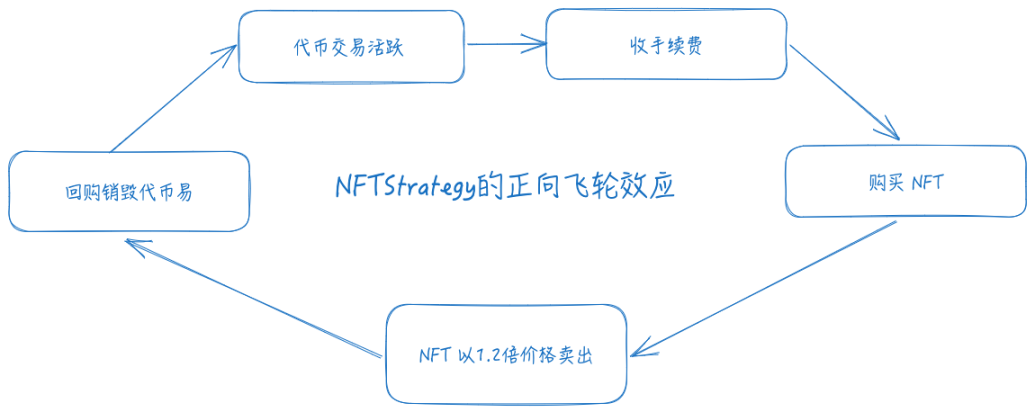
In addition to the basic flywheel, NFTStrategy has also designed a Dutch auction issuance mechanism to avoid on-chain snipers. At the start, the trading fee for the token is set at 95%, and then it decreases by 1% every minute until it reaches a minimum of 10%. This mechanism effectively avoids snipers using scripts to gain a speed advantage at the beginning of the issuance, ensuring equal entry opportunities for early participants.
Next, I will explain the reasons for my purchase at that time, which are twofold:
First, I believe that NFTStrategy is fundamentally very similar to the micro-strategy BTC vault strategy. Both target markets with liquidity mismatch issues and have broad attention. Micro-strategy addresses the inefficiency of capital flowing into the cryptocurrency market from traditional financial markets, where there is a broad base of retail investors in the cryptocurrency market, which helps to rapidly disseminate the mechanism through network effects. NFTStrategy, on the other hand, targets the high-priced NFT market. Due to the unique characteristics of non-fungible tokens and their high prices, ordinary cryptocurrency investors cannot purchase them. However, blue-chip NFT holders generally have a wide influence on social media, allowing for quick outreach to this demographic and leveraging their influence for rapid dissemination.
Secondly, in terms of the launch method, NFTStrategy adopted a Fair Launch approach with good anti-snipe design, which resulted in a relatively even distribution of early tokens. With a healthier turnover rate, the price trend is likely to be more stable. Additionally, due to the initially low liquidity, as long as trading volume can be ensured, the accumulated buyback funds from the 10% high fee can lead to a small amount of purchasing power that effectively drives price increases, creating a good wealth effect that can quickly attract speculators.
As for the risks, they mainly stem from the termination of positive feedback brought about by two factors:
Decline in Vault NFT Prices: This is relatively easy to understand. As a value support, if the price of the reserve NFTs declines, it will lead to a decrease in the intrinsic value of the tokens. However, I believe this risk is currently low. First, blue-chip NFTs tend to have low liquidity, so their turnover is not frequent, and price fluctuations are not severe. Second, most NFTs are priced in ETH, so as long as ETH's price trend rises, it will also drive up the value of NFTs, which is a clever aspect. Finally, the main source of funds for the buybacks of current Strategy tokens comes from accumulated fees (1% of each transaction), rather than low buying and high selling of NFTs. Even if NFT prices decline, as long as overall trading volume can be maintained, the buyback power will effectively support the price.
Decline in Trading Volume: I believe this is the biggest risk. As the influence of the tokens increases, external exchange liquidity will rise, for example, CEX may choose to list the token, and other DEXs will also attract liquidity providers. This migration of liquidity will lead to trading volume being dispersed across other trading platforms, while the Strategy tokens rely on Uniswap V4 hook to distribute the 10% trading fee. This will prevent them from profiting from turnover on other exchanges, and as the accumulated fees decrease, the buyback power will diminish, significantly reducing the token's attractiveness. This marks the beginning of negative feedback. Therefore, monitoring liquidity and trading volume is the most critical factor in assessing its trading value.
免责声明:本文章仅代表作者个人观点,不代表本平台的立场和观点。本文章仅供信息分享,不构成对任何人的任何投资建议。用户与作者之间的任何争议,与本平台无关。如网页中刊载的文章或图片涉及侵权,请提供相关的权利证明和身份证明发送邮件到support@aicoin.com,本平台相关工作人员将会进行核查。



